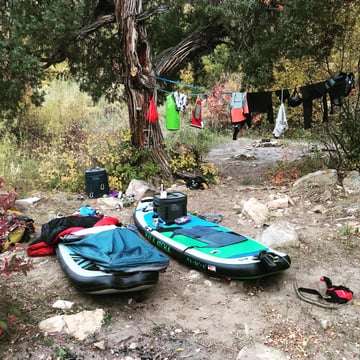 Colorado hosts millions of outdoor enthusiasts and they all have something in common: a sense of stewardship for the land. In the last few years the demand for camping and outdoor gear has skyrocketed and production can’t keep up. It probably shouldn’t - creating new products is very taxing on the very environment that outdoor enthusiasts are trying to get out to. Think about what goes into making a jacket. Fibers have to be created into textiles; textiles are dyed using hundreds of gallons of water while creating a toxic waste; does it have synthetic insulation or down? Synthetic insulation is usually made of some sort of petrol-based plastic and down insulation requires animal farming that can be harmful for birds and humans alike. Does it have a durable water repellent? Is that PFC based? Because so much goes into making new gear, it's important to prolong the life of the gear you already have! Here are some tips to do just that:
Colorado hosts millions of outdoor enthusiasts and they all have something in common: a sense of stewardship for the land. In the last few years the demand for camping and outdoor gear has skyrocketed and production can’t keep up. It probably shouldn’t - creating new products is very taxing on the very environment that outdoor enthusiasts are trying to get out to. Think about what goes into making a jacket. Fibers have to be created into textiles; textiles are dyed using hundreds of gallons of water while creating a toxic waste; does it have synthetic insulation or down? Synthetic insulation is usually made of some sort of petrol-based plastic and down insulation requires animal farming that can be harmful for birds and humans alike. Does it have a durable water repellent? Is that PFC based? Because so much goes into making new gear, it's important to prolong the life of the gear you already have! Here are some tips to do just that:
- Wash your Stuff: Washing your gear is an important part of prolonging its life. From tents to sleeping bags to rain gear, you should regularly wash your gear. Besides extending the life of your gear, I can almost guarantee that your gear is probably pretty gross. You should wash it. For soft gear, I recommend exploring Nikwax’s product line to find the correct wash for each piece of gear. For hardgoods like water reservoirs, a good brush goes a long way.
- Use a Footprint for your Tent: Tents these days are made lighter and lighter - to the point where they are almost tissue paper. You can extend the life of your tent by simply using a footprint! The footprint will add an extra layer under your tent to protect it from punctures while keeping it a little cleaner and drier. Tent manufacturers will make footprints for your specific tent, or you can use a regular old tarp.
- Treat your Waterproof Gear: Did you know that your rainshell can lose its waterproofing? Same with any garment that has a durable water repellent (DWR) treatment! Keeping your rainshell clean (see first tip) can help reactivate the DWR it came with. If it’s really struggling to keep you dry, consider retreating it with a DWR treatment, like Nikwax or similar.
- Repair! Don’t replace!: Punctured your puffy? Zipper just won’t zip? Button fell off? Fix it! You can do it yourself with repair kits like Gear Aid and tons of YouTube videos to help you out. Have a more complicated repair? Most outdoor brands will have repair programs where you send in your item and they fix it for low or no cost!
Keeping up with regular gear maintenance will help prolong the life of the gear you already own, saving some strain on the environment and your wallet!
Sometimes though, gear needs to be replaced. It could be broken beyond repair, maybe it doesn’t fit, it’s unsafe to use, or it just does not properly function. The outdoor industry has recognized that the environment is impacted by the products they make and have begun to take strides towards a more sustainable economy. After all, the outdoor industry has a vested interest in protecting the environment - their jobs depend on the environment! The Outdoor Industry Association (OIA) - comprised of over 1,200 organizations and individuals - has taken aim to a lofty goal: be the first climate positive industry by 2030. The OIA provides members with resources to track their impact and offer ways for members to lower that impact, while also working throughout the industry to look for innovative ways to reach their goal. So if the industry is working so hard towards being climate positive, what should you do if you’re in the market for some new gear?
First and foremost, check out used gear. If you know what to look out for, you can find some serious deals on sweet pieces of gear. Unless it’s a piece of gear that you put your life into (a climbing harness and rope, for example), used gear is the way to go! If you absolutely must buy new, here’s some criteria to consider when choosing your new gear:
Fair Trade Items:

You have probably heard of Fair Trade products before. When a product is certified fair trade, it means that the product has gone through a rigorous certification process ensuring that the people who created that product had safe working conditions and sustainable livelihoods, while the company itself worked towards environmental protection and contributed to community development funds. Pretty much anything can be Fair Trade Certified, from food to clothes to - you guessed it - gear! Look for the fair trade symbol when you’re shopping for gear.
Responsibly Sourced Down

The Responsible Down Standard (RDS) is a certification that is awarded only to companies and items that responsibly source their down. RDS looks at the supply chain to ensure that no bird experienced unnecessary harm and lived with the Five Freedoms of Animal Welfare: freedom from hunger and thirst; freedom from discomfort; freedom from pain, injury, and disease; freedom to express normal and natural behavior; and freedom from fear and distress. You’ll see the logo on things like sleeping bags and coats.
Innovative Materials
Organic cotton, hemp, solution-dyed fabrics, PCF-Free rain gear, bio-materials are all examples of innovative materials you can look for in new gear. My favorite of these is the application of solution-dyed fabrics in gear. Solution-dyed fabrics and textiles are more resistant to UV damage from the sun and overall more durable. They also take less energy to produce versus traditional dying, it takes less water, and fewer chemicals - resulting in far less waste water, which is usually toxic. Big Agnes (a Colorado company!) recently unveiled their own line of solution-dyed tents so be sure to check them out when you’re in the market for a new tent!
Recycled Materials
While we cannot purely recycle our way out of climate change, using recycled materials puts far less strain on the environment than using new or virgin materials. Many outdoor brands like Patagonia, The North Face, Fjällraven, and more have put emphasis on using recycled materials in their products. Does the synthetic insulation in a jacket really need to be brand new material? Probably not! Look for items that have recycled content on their tags.
B-Corporations

B-Corporations work towards a common goal: make the world a better place through good business practices. B Corps work towards reducing inequality, lowering levels of poverty, contributing to a healthier environment, stronger communities, and creating more “high quality jobs with dignity and purpose.” Not just any company can be a B Corporation. They have to go through a rigorous and thorough certification process to ensure that a company has a measured positive impact on the environment, community, and economy. Most companies that are certified will have the badge at the bottom of their website, so you can feel good about supporting them.
With the help of these tips, you can be sure to make a more informed decision when it comes to choosing your new gear.
Courtney Rajt was a Sustainability Intern with Walking Mountains Science Center.






